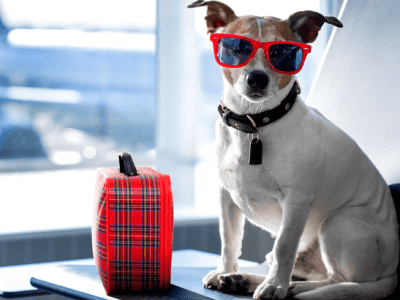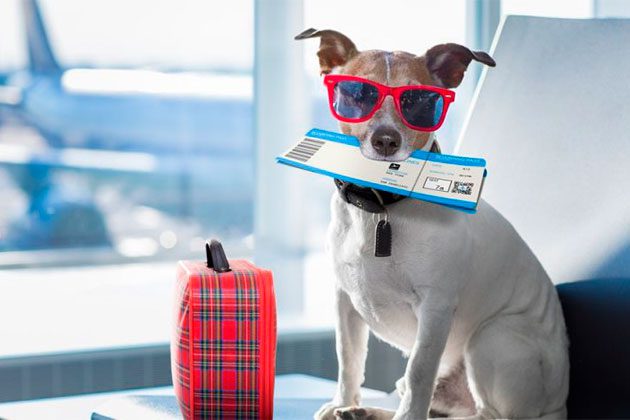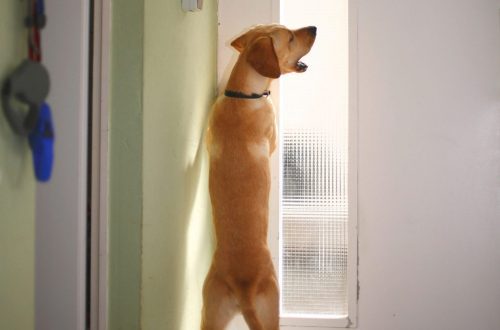
Traveling with a pet – how to prepare?

Contents
Documents required for the transportation of cats and dogs
- It is necessary to study in advance the rules of transportation, as well as the requirements of the transport company whose services you are going to use, as they may differ.
- Find out the veterinary regulations of the country where you are going to travel with your pet.
- Translate the veterinary requirements of the country where you are going into Russian on your own.
- It is necessary to apply to the state service for the fight against animal diseases with the translated requirements of the country you are going to. Based on these rules, veterinarians will, if necessary, carry out the necessary studies to prepare the cat or dog for transportation abroad.
- Veterinary passport. It should contain marks on vaccinations, treatments for ecto- and endoparasites (fleas, ticks, helminths). Passport must be issued in advance, at least a month before the intended transportation. If you have never vaccinated your pet, then you will need to protect your pet from rabies by getting vaccinated, as this is a mandatory requirement. It often happens that in order to travel abroad, a dog must be microchipped; this is also marked or labeled with the chip number in the veterinary passport.
- Within five days before the planned date of departure, issue a veterinary certificate form No. 1 in the SBBZH, and certify it there.
How to prepare your pet for travel
- It is recommended not to feed the animal before the trip, or to limit the portion. Especially if you know that a cat or dog gets motion sickness in transport.
- If the journey is long, then stock up on food, fresh water in a bottle, a convenient stable or hanging bowl, and a travel container for food.
- Various hygiene items may be required: absorbent diapers or diapers, wet wipes, pet cleaning bags.
- Do not forget comfortable ammunition and a muzzle.
- Choose a suitable carrier or container in advance, the animal should fit freely in it, be able to stand up and lie down.
- In order to make it easier for a cat or dog to endure the road and a further change of scenery, it is recommended to use sedatives in the form of drops and tablets. You can also use collars, drops on the withers, sprays and suspensions.
- You can take your favorite toys, treats and a blanket on which your pet usually sleeps with you on a trip; familiar items will calm the animal down a bit.
- Write down the phone numbers and addresses of local veterinary clinics in advance.
First aid kit for a pet
Basic list of drugs for first aid.
- If your animal has chronic diseases, do not forget to take drugs that you use on an ongoing basis, or that stop the pathological process.
- Bandages, cotton wool, wipes, adhesive bandage, hemostatic sponge
- Chlorhexidine, hydrogen peroxide, Ranosan powder or ointment
- Tiktwister (pliers twister)
- Thermometer
- Ondasentron or Serenia for vomiting
- Enterosgel and / or Smecta, activated carbon. Relief of diarrhea and removal of intoxication
- Loxikom or Petkam. Anti-inflammatory and antipyretic drugs
- Calming drugs, in case the pet is nervous on the road
Traveling by public transport
Each region has its own nuances. You can check with your municipality for details. As a rule, there are no problems with the transportation of small dogs and cats; this requires a special carrier. Its forms can be different, the main thing is that the pet does not accidentally jump out of it, as this is very dangerous. Large breed dogs are allowed in many forms of ground transportation. In this case, the following are required: a short leash, a comfortable muzzle and a ticket for the animal. Large dogs cannot be transferred to the subway, small and medium-sized dogs must be carried in a carrying bag or on hands, especially on the escalator, except for guide dogs.
Transportation of animals by rail
For trips with a cat or a dog of small size, special carriages are provided on trains, in which medium-sized animals can be transported. If the dog is large, the ransom of the whole compartment is required. If a cat or a small dog is transported in a compartment, they can be let out of the carrier during the journey, but the animal must be on a leash, in a collar or harness, without the possibility of escaping. Small pets and birds are transported in a container or cage, the size of which does not exceed 120 cm in the sum of three dimensions, while the weight of the carrier together with the animal should not exceed 10 kg.
The container/cage must be spacious enough, have ventilation holes and a reliable locking device to prevent spontaneous opening or unauthorized access to the animal. The bottom of the container/cage should be tight, waterproof and covered with absorbent material such as disposable diapers.
Keep your pet clean and hygienic on the train. Stock up on diapers, dry and wet wipes, garbage bags. Dogs of large and giant breeds must be muzzled, the leash must also be at hand. Guide dogs are transported free of charge and must be on a leash and muzzled.
You can order the service no later than two days before the date of departure of the train if you have a purchased travel document. The cost of the service for the transportation of small pets for passengers of first and business class carriages is not included in the cost of the travel document and is paid separately.
It is better to find out more detailed information on the Russian Railways website in advance, as the requirements for the transportation of animals may differ depending on the type of train and the seats on which the passenger is accommodated.
Flight
It is better to check the requirements of the carrier company on the website in advance, as they may have different requirements for the size of the carrier. Dogs and cats as non-standard baggage are transported in a carrier in the passenger cabin or in the luggage compartment. The weight of the container with the pet inside must be no more than 8 kg. No more than 5 animals are allowed in the aircraft cabin. Be sure to notify that you have a pet with you when booking, purchasing an air ticket or by calling the airline no later than 36 hours before the scheduled flight departure time, since animals are transported only with the consent of the airline, and there are restrictions on the number and types of transported animals. The following are not accepted for transportation as a special type of non-standard baggage:
- brachycephalic dogs: Bulldog (English, French, American), Pug, Pekingese, Shih Tzu, Boxer, Griffin, Boston Terrier, Dogue de Bordeaux, Japanese Chin
- rodents (guinea pig, rat, chinchilla, squirrel, gerbil, mouse, degu)
- reptiles
- arthropods (insects, arachnids, crustaceans)
- fish, marine and river animals requiring transportation in water
- sick animals/birds
- animals weighing more than 50 kg together with the container.
At the same time, in addition to dogs and cats, you can transport tame fennecs, ferrets, loris, meerkats, decorative hedgehogs and rabbits. The pet will also need to be checked in, so try to arrive at the airport early.
A service dog of the canine service of the federal executive authorities may be transported in the passenger cabin without a container, provided it has a collar, muzzle and leash. Restrictions on breed and weight do not apply to the dog of the cynological service.
A guide dog accompanying a passenger with a disability is transported in the passenger cabin free of charge in excess of the free carry-on baggage allowance.
When checking in for a flight, the passenger must present:
- a veterinary passport to confirm that the animal is healthy, vaccinated and has the right to move. Examination by a veterinarian or veterinary control specialist (if required) must be carried out no earlier than 5 days before the date of departure;
- documents necessary for the movement of the animal in accordance with the requirements of the legislation of the country, from the territory, into the territory or through the territory of which the transportation is carried out (if required);
- for the free transportation of a guide dog, the passenger must present a document confirming the disability and a document confirming the training of the dog;
- in order to transport a service dog of the cynological service in the passenger cabin, the passenger must present a document confirming the special training of the service dog, and a document stating that the passenger carrying the service dog is an employee of the cynological service of the federal executive body.
When requesting the carriage of an animal, a passenger may be denied for the following reasons:
- It is impossible to ensure the proper air temperature in the luggage compartment due to the design features of the type of aircraft (unheated luggage compartment);
- An animal is not accepted as baggage for transportation in the cabin and in the luggage compartment;
- There is a prohibition or restriction on the import/export of animals/birds by a passenger as baggage (London, Dublin, Dubai, Hong Kong, Tehran, etc.) in accordance with the laws of the country, into, from or through the territory of which the carriage is carried out.
- The breed of the dog does not match the one specified in the transportation request.
- The owner has no accompanying documents, the dog is without a leash and a muzzle, shows aggression towards others, the transportation container does not meet the requirements of the company.
Personal car
Perhaps the most pleasant and convenient way for a pet to transport. In a car, a carrier with a dog or cat must be secured with straps, or use a special seat belt that is attached to the dog’s harness. You can also pass the seat belt under the top strap of the dog harness, which will prevent falling out of the chair when braking. It is advisable to use hammocks and soft baskets for dogs. In no case should a pet distract the driver, limit his view, and move freely around the cabin. Documents are needed the same as for transportation by other modes of transport. For trips around Russia, a veterinary passport with the necessary marks is enough.
Taxi
It is better to call a special zootaxi. So you will avoid a lot of problems, as the cars are equipped with cages and mats for transporting pets. If it is not possible to call a zootaxi, be sure to indicate when ordering that an animal is traveling with you in a carrier or with a diaper or a special rug. Small animals, including cats and dogs of small breeds, must be in a carrier in a taxi, dogs without a carrier must be on a leash and muzzled.





